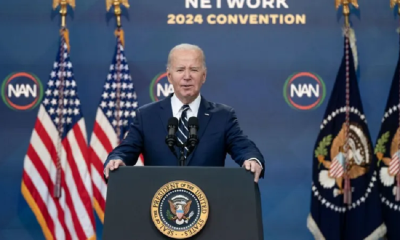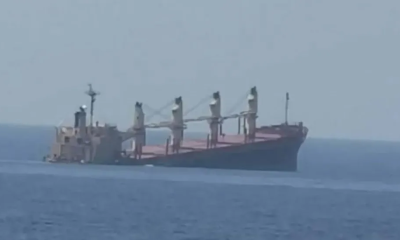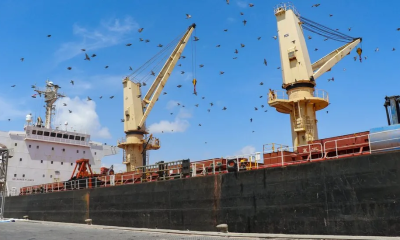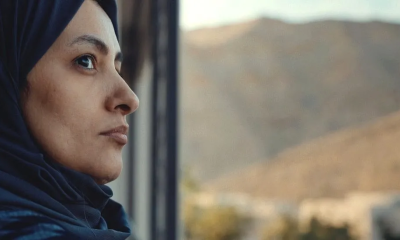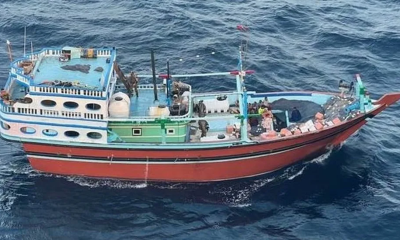Features
Nimisha Priya: The Indian nurse from Kerala on death row in Yemen
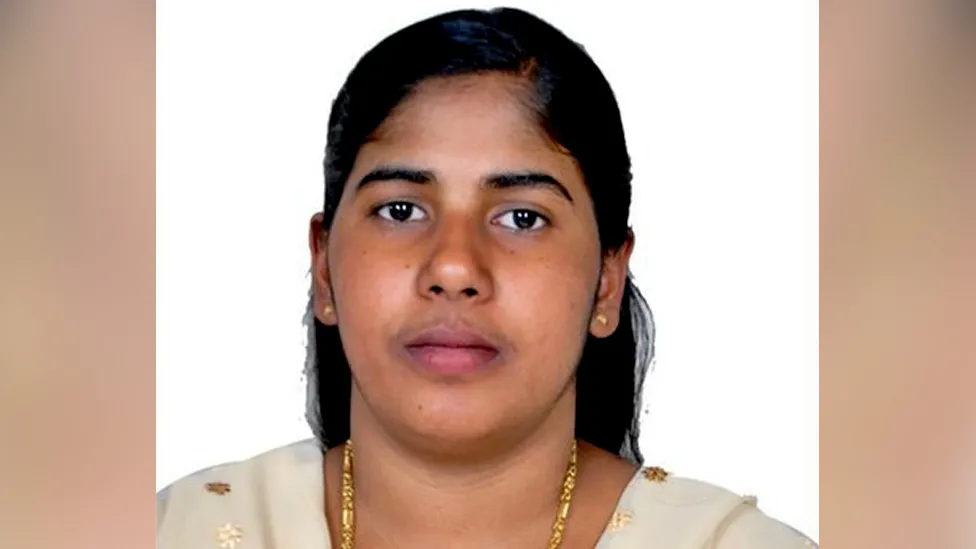
Nimisha Priya, barely 19, left the southern Indian state of Kerala for Yemen in 2008 with big dreams.
She had found work as a nurse in a government-run hospital in the capital Saan’a and told her mother, a poorly-paid domestic helper, that their days of hardships would be over soon.
Fifteen years later, that dream has turned into a nightmare for Nimisha and her family. The 34-year-old is on death row for murdering a local man, Talal Abdo Madhi. She’s counting out her days in Sana’a central jail in the capital of the war-torn country.
On 13 November, Yemen’s Supreme Judicial Council rejected her appeal, clearing the decks for her execution. But as Yemen follows Sharia law, the court gave her one last option of escaping death – she can secure a pardon from the victim’s family by paying diyah or “blood money”. Now, her family and campaigners are racing against time, hoping to pull a miracle and get that pardon that would allow her to live.
‘Take my life instead’
Prema Kumari, Nimisha’s 57-year-old mother, breaks down repeatedly as she describes her daughter’s ordeal.
“I will go to Yemen and seek their forgiveness. I will apologise to them, I’ll tell them, take my life but please spare my daughter,” says Prema Kumari who lives in the southern Indian city of Kochi. “Nimisha has a young daughter who needs her mother.”
But travelling to Yemen is not easy. A 2017 Indian government ban on citizens travelling to Yemen remains and those needing to travel need special permission.
A lobby group called Save Nimisha Priya International Action Council has filed a petition in the Delhi high court, seeking permission for Nimisha’s mother and her 11-year-old daughter Mishal to travel to Sana’a. It said two council members would accompany them.
But last Friday, Indian authorities rejected the request, saying they didn’t have a diplomatic presence in Yemen to ensure their safety.
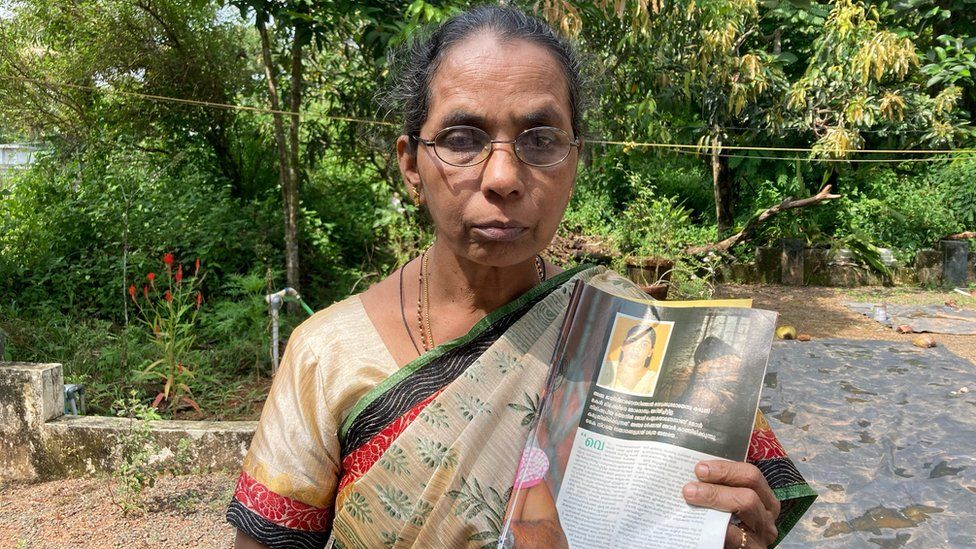
The government’s assessment is based on the political condition in Yemen. Saan’a is controlled by Houthi rebels who have been locked in a prolonged civil war with Yemen’s official government , which is based in-exile in Saudi Arabia. India does not recognise Houthis so a trip to Yemen for Indian citizens is bound to be fraught with dangers – they will have to fly to Aden and then travel for 12-14 hours to Sana’a by road.
The Save Nimisha council has once again approached the Delhi high court, renewing its request to allow her mother and daughter to travel to Yemen. And with each passing day, Prema Kumari’s desperation is growing. “I don’t want my daughter to die in a foreign land,” she says.
“What happened to Nimisha is very unfortunate, she doesn’t deserve it,” says Babu John, social activist and member of the Save Nimisha council. He adds that Nimisha was looking at a bright future but got stranded in Yemen when the civil war broke out.
Nimisha, her mother says, was good at studies and the local church supported her school education and paid for her nursing diploma course. But she was ineligible for a nursing job in Kerala because she hadn’t cleared her school leaving exams before doing the diploma.
The job in Yemen was meant to be her ticket out of crippling poverty.
In 2011, she returned home to marry Tomy Thomas in a match arranged by her family. The couple returned to Yemen, where he found work as an electrician’s assistant, but the pay was paltry. After December 2012, when their daughter was born, they struggled to make a living and in 2014, Thomas returned along with the child to Kochi where he now drives a tuk-tuk.
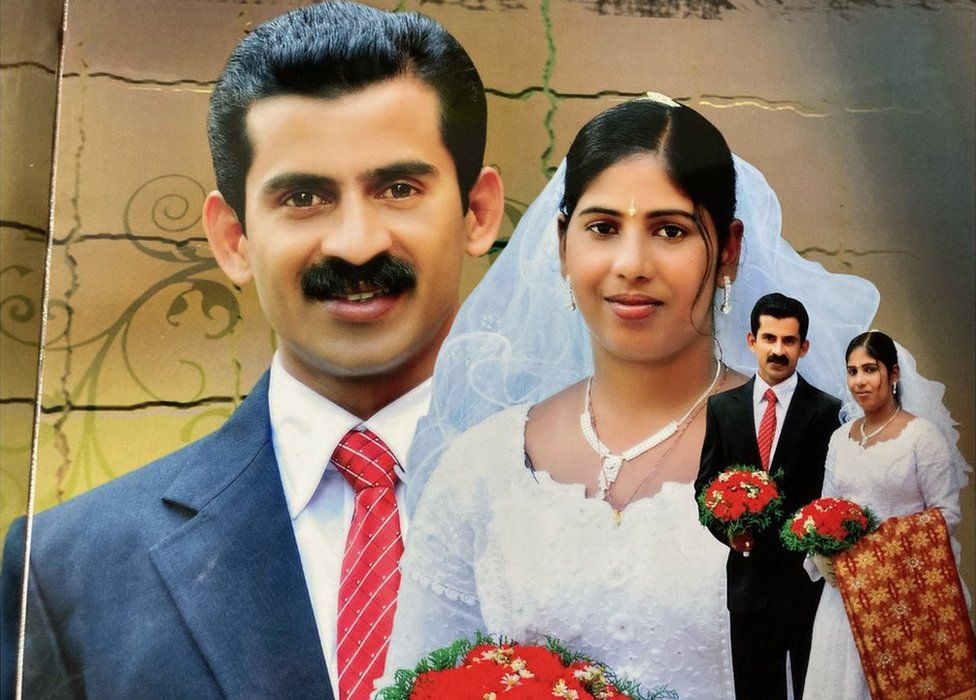

Nimisha decided to quit her low-paying job and start her own clinic in 2014. But the law in Yemen mandated her to have a local as a partner and that’s where Mahdi came into the picture. He ran a textile store nearby and his wife had given birth in the clinic where Nimisha worked. In January 2015, when Nimisha came home for her daughter’s baptism, Mahdi came along for a holiday.
Nimisha and her husband borrowed money from friends and family, together raising 5m rupees ($60,000; £47,000), and a month later, Nimisha returned to Yemen to start her clinic. She also started the paperwork so her husband and daughter could join her in Yemen, but in March, a civil war broke out there and they couldn’t travel.
Over the next two months, India evacuated 4,600 citizens and nearly 1,000 foreign nationals from Yemen. Nimisha was among a few hundreds who did not leave. “We had invested so much money in the clinic and she couldn’t just get up and leave,” Thomas says.
On his phone, he shows me photographs of the 14-bed clinic – the signboard of the Al Aman Medical Clinic, spanking new blue chairs in the reception area, a man in a white coat posing next to brand new lab equipment, a new Sony TV mounted on a wall in the waiting room, and Mahdi sitting in the pharmacy.
The clinic, Thomas says, soon started doing well, but Nimisha also started to complain about Mahdi.
According to the petition in the Delhi high court – which the BBC has seen – Mahdi “stole a photograph of Nimisha’s wedding when he visited their home in Kochi and he later manipulated it to claim he was married to Nimisha”.
It says that “he physically tortured her and took away all the revenue collection from the clinic” and that their “relationship deteriorated when Nimisha questioned him about embezzlement of funds”.
On several occasions, “he threatened her with a gun” and “seized her passport to prevent her from leaving”. And when she complained to the police, “instead of taking any action against him, they locked her up for six days”, it adds.
The murder – and the arrest
Thomas first learnt about the murder in 2017 through TV news channels.
“The headline was – Malayali [Kerala] nurse Nimisha Priya arrested for murdering husband, chopping up his body in Yemen,” he says. Nimisha was arrested from close to Yemen’s border with Saudi Arabia – more than a month after Mahdi’s chopped up body was found in a water tank.
“How could this man be her husband when she was married to me?” he asks while showing me their wedding album.
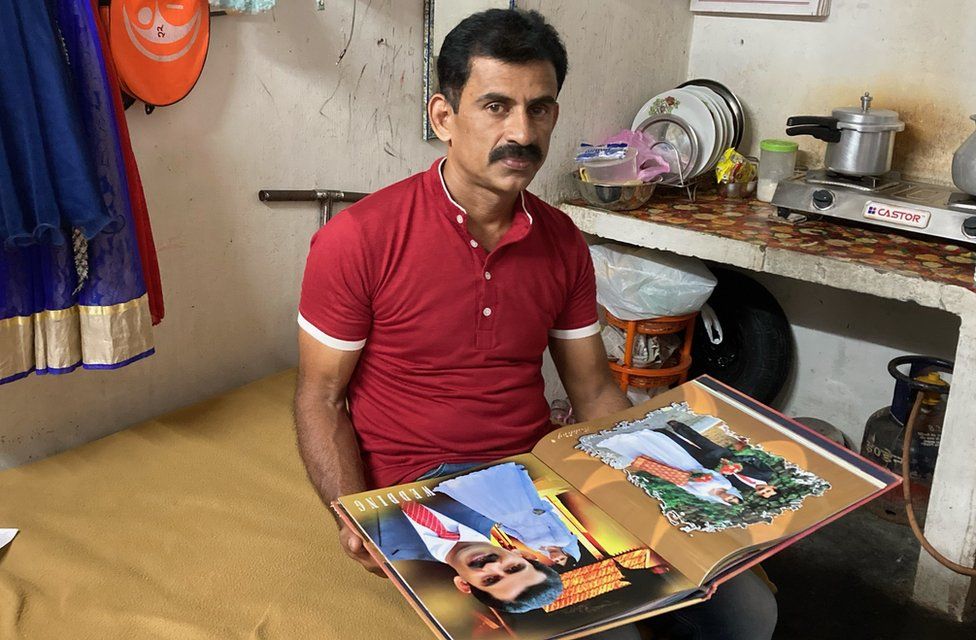

Tomy Thomas says when she called him from prison a few days after her arrest, they both cried. “She said she had done all this for me and our child. She could have taken the easy way and lived with Mahdi, but she didn’t want to do that. My love and affection for her has grown after this ordeal.”
KR Subhash Chandran, a migrant rights activist and Supreme Court lawyer who is representing Nimisha’s mother and the council in the Delhi high court, says “Nimisha did not really intend to kill Mahdi” and that “she too is a victim”.
“Mahdi had confiscated her passport and she was trying to get it back from him. So, she tried to sedate him, but she overdosed him and he died,” he says.
The exploitation of semi-skilled and unskilled Indian workers in Gulf countries is well documented. Activists say many countries in the region practice Kafala – which means the employer keeps a worker’s passport and documents. International Labour Organization says it’s slavery by another name and opens migrant works to all sorts of abuse.
Most victims of Kafala, Chandran says, are Indian women who go to the Middle East to work as domestic workers, trying to escape poverty at home.
He is now also calling for “a retrial so Nimisha has a chance to defend herself”.
“She did not receive a proper legal trial. The court appointed a junior lawyer to represent her but she couldn’t communicate with him because she doesn’t know any Arabic. She wasn’t given an interpreter and she had no idea what documents she was signing,” he says.
Yemeni authorities have not commented on the case in Delhi.
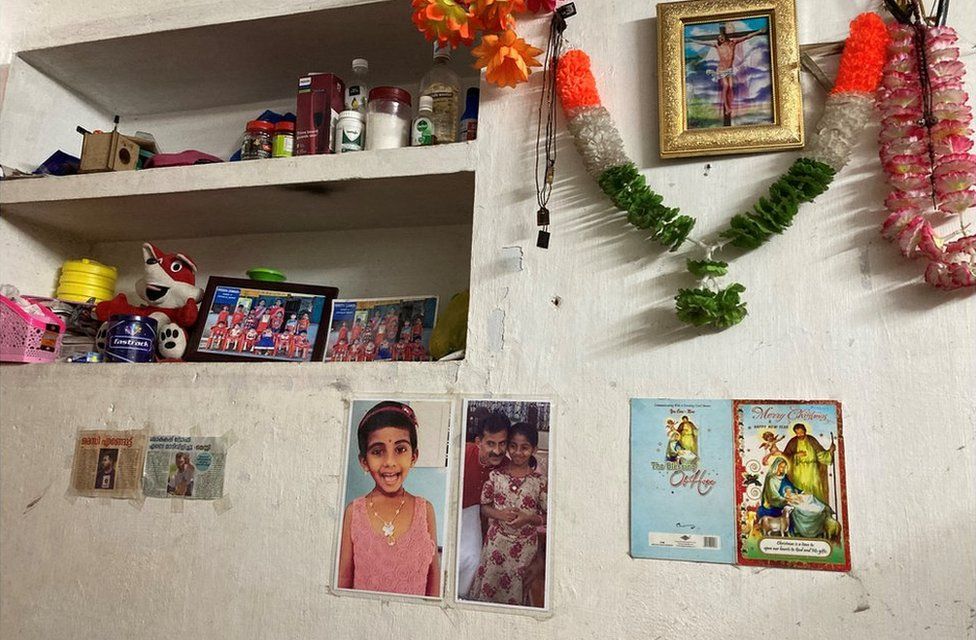

Deepa Joseph, lawyer and social activist and vice-chair of the Save Nimisha council, says the Indian government’s support is key to saving Nimisha. “The only option is to seek forgiveness from Mahdi’s family and negotiate blood money with them.”
A well-known business tycoon from Kerala has already pledged 10m rupees ($112,000 ;£95,000) to the cause. And the council is confident that Kerala residents at home and in the diaspora would contribute to make up any shortfall.
“I have full hope that Nimisha can be saved. I think the victim’s family will accept the blood money,” Ms Joseph says. “She may have committed a serious crime but I want to save her for her mother and her daughter.”
Prema Kumari is now hoping to travel to Yemen and speak to Mahdi’s family.
When Mr Thomas spoke to his wife just days before Yemen’s Supreme Council rejected her appeal, Nimisha sounded hopeful. “Keep your strength and pray for me,” she’d told him. But when he spoke to her after the court decision, she sounded “depressed”.
“I tried to console her by saying that efforts were being made to save her life, but she didn’t sound convinced. How can I remain hopeful? she asked me,” he said.
(BBC)
Features
The heart-friendly health minister

by Dr Gotabhya Ranasinghe
Senior Consultant Cardiologist
National Hospital Sri Lanka
When we sought a meeting with Hon Dr. Ramesh Pathirana, Minister of Health, he graciously cleared his busy schedule to accommodate us. Renowned for his attentive listening and deep understanding, Minister Pathirana is dedicated to advancing the health sector. His openness and transparency exemplify the qualities of an exemplary politician and minister.
Dr. Palitha Mahipala, the current Health Secretary, demonstrates both commendable enthusiasm and unwavering support. This combination of attributes makes him a highly compatible colleague for the esteemed Minister of Health.
Our discussion centered on a project that has been in the works for the past 30 years, one that no other minister had managed to advance.
Minister Pathirana, however, recognized the project’s significance and its potential to revolutionize care for heart patients.
The project involves the construction of a state-of-the-art facility at the premises of the National Hospital Colombo. The project’s location within the premises of the National Hospital underscores its importance and relevance to the healthcare infrastructure of the nation.
This facility will include a cardiology building and a tertiary care center, equipped with the latest technology to handle and treat all types of heart-related conditions and surgeries.
Securing funding was a major milestone for this initiative. Minister Pathirana successfully obtained approval for a $40 billion loan from the Asian Development Bank. With the funding in place, the foundation stone is scheduled to be laid in September this year, and construction will begin in January 2025.
This project guarantees a consistent and uninterrupted supply of stents and related medications for heart patients. As a result, patients will have timely access to essential medical supplies during their treatment and recovery. By securing these critical resources, the project aims to enhance patient outcomes, minimize treatment delays, and maintain the highest standards of cardiac care.
Upon its fruition, this monumental building will serve as a beacon of hope and healing, symbolizing the unwavering dedication to improving patient outcomes and fostering a healthier society.We anticipate a future marked by significant progress and positive outcomes in Sri Lanka’s cardiovascular treatment landscape within the foreseeable timeframe.
Features
A LOVING TRIBUTE TO JESUIT FR. ALOYSIUS PIERIS ON HIS 90th BIRTHDAY

by Fr. Emmanuel Fernando, OMI
Jesuit Fr. Aloysius Pieris (affectionately called Fr. Aloy) celebrated his 90th birthday on April 9, 2024 and I, as the editor of our Oblate Journal, THE MISSIONARY OBLATE had gone to press by that time. Immediately I decided to publish an article, appreciating the untiring selfless services he continues to offer for inter-Faith dialogue, the renewal of the Catholic Church, his concern for the poor and the suffering Sri Lankan masses and to me, the present writer.
It was in 1988, when I was appointed Director of the Oblate Scholastics at Ampitiya by the then Oblate Provincial Fr. Anselm Silva, that I came to know Fr. Aloy more closely. Knowing well his expertise in matters spiritual, theological, Indological and pastoral, and with the collaborative spirit of my companion-formators, our Oblate Scholastics were sent to Tulana, the Research and Encounter Centre, Kelaniya, of which he is the Founder-Director, for ‘exposure-programmes’ on matters spiritual, biblical, theological and pastoral. Some of these dimensions according to my view and that of my companion-formators, were not available at the National Seminary, Ampitiya.
Ever since that time, our Oblate formators/ accompaniers at the Oblate Scholasticate, Ampitiya , have continued to send our Oblate Scholastics to Tulana Centre for deepening their insights and convictions regarding matters needed to serve the people in today’s context. Fr. Aloy also had tried very enthusiastically with the Oblate team headed by Frs. Oswald Firth and Clement Waidyasekara to begin a Theologate, directed by the Religious Congregations in Sri Lanka, for the contextual formation/ accompaniment of their members. It should very well be a desired goal of the Leaders / Provincials of the Religious Congregations.
Besides being a formator/accompanier at the Oblate Scholasticate, I was entrusted also with the task of editing and publishing our Oblate journal, ‘The Missionary Oblate’. To maintain the quality of the journal I continue to depend on Fr. Aloy for his thought-provoking and stimulating articles on Biblical Spirituality, Biblical Theology and Ecclesiology. I am very grateful to him for his generous assistance. Of late, his writings on renewal of the Church, initiated by Pope St. John XX111 and continued by Pope Francis through the Synodal path, published in our Oblate journal, enable our readers to focus their attention also on the needed renewal in the Catholic Church in Sri Lanka. Fr. Aloy appreciated very much the Synodal path adopted by the Jesuit Pope Francis for the renewal of the Church, rooted very much on prayerful discernment. In my Religious and presbyteral life, Fr.Aloy continues to be my spiritual animator / guide and ongoing formator / acccompanier.
Fr. Aloysius Pieris, BA Hons (Lond), LPh (SHC, India), STL (PFT, Naples), PhD (SLU/VC), ThD (Tilburg), D.Ltt (KU), has been one of the eminent Asian theologians well recognized internationally and one who has lectured and held visiting chairs in many universities both in the West and in the East. Many members of Religious Congregations from Asian countries have benefited from his lectures and guidance in the East Asian Pastoral Institute (EAPI) in Manila, Philippines. He had been a Theologian consulted by the Federation of Asian Bishops’ Conferences for many years. During his professorship at the Gregorian University in Rome, he was called to be a member of a special group of advisers on other religions consulted by Pope Paul VI.
Fr. Aloy is the author of more than 30 books and well over 500 Research Papers. Some of his books and articles have been translated and published in several countries. Among those books, one can find the following: 1) The Genesis of an Asian Theology of Liberation (An Autobiographical Excursus on the Art of Theologising in Asia, 2) An Asian Theology of Liberation, 3) Providential Timeliness of Vatican 11 (a long-overdue halt to a scandalous millennium, 4) Give Vatican 11 a chance, 5) Leadership in the Church, 6) Relishing our faith in working for justice (Themes for study and discussion), 7) A Message meant mainly, not exclusively for Jesuits (Background information necessary for helping Francis renew the Church), 8) Lent in Lanka (Reflections and Resolutions, 9) Love meets wisdom (A Christian Experience of Buddhism, 10) Fire and Water 11) God’s Reign for God’s poor, 12) Our Unhiddden Agenda (How we Jesuits work, pray and form our men). He is also the Editor of two journals, Vagdevi, Journal of Religious Reflection and Dialogue, New Series.
Fr. Aloy has a BA in Pali and Sanskrit from the University of London and a Ph.D in Buddhist Philosophy from the University of Sri Lankan, Vidyodaya Campus. On Nov. 23, 2019, he was awarded the prestigious honorary Doctorate of Literature (D.Litt) by the Chancellor of the University of Kelaniya, the Most Venerable Welamitiyawe Dharmakirthi Sri Kusala Dhamma Thera.
Fr. Aloy continues to be a promoter of Gospel values and virtues. Justice as a constitutive dimension of love and social concern for the downtrodden masses are very much noted in his life and work. He had very much appreciated the commitment of the late Fr. Joseph (Joe) Fernando, the National Director of the Social and Economic Centre (SEDEC) for the poor.
In Sri Lanka, a few religious Congregations – the Good Shepherd Sisters, the Christian Brothers, the Marist Brothers and the Oblates – have invited him to animate their members especially during their Provincial Congresses, Chapters and International Conferences. The mainline Christian Churches also have sought his advice and followed his seminars. I, for one, regret very much, that the Sri Lankan authorities of the Catholic Church –today’s Hierarchy—- have not sought Fr.
Aloy’s expertise for the renewal of the Catholic Church in Sri Lanka and thus have not benefited from the immense store of wisdom and insight that he can offer to our local Church while the Sri Lankan bishops who governed the Catholic church in the immediate aftermath of the Second Vatican Council (Edmund Fernando OMI, Anthony de Saram, Leo Nanayakkara OSB, Frank Marcus Fernando, Paul Perera,) visited him and consulted him on many matters. Among the Tamil Bishops, Bishop Rayappu Joseph was keeping close contact with him and Bishop J. Deogupillai hosted him and his team visiting him after the horrible Black July massacre of Tamils.
Features
A fairy tale, success or debacle

Sri Lanka-Singapore Free Trade Agreement
By Gomi Senadhira
senadhiragomi@gmail.com
“You might tell fairy tales, but the progress of a country cannot be achieved through such narratives. A country cannot be developed by making false promises. The country moved backward because of the electoral promises made by political parties throughout time. We have witnessed that the ultimate result of this is the country becoming bankrupt. Unfortunately, many segments of the population have not come to realize this yet.” – President Ranil Wickremesinghe, 2024 Budget speech
Any Sri Lankan would agree with the above words of President Wickremesinghe on the false promises our politicians and officials make and the fairy tales they narrate which bankrupted this country. So, to understand this, let’s look at one such fairy tale with lots of false promises; Ranil Wickremesinghe’s greatest achievement in the area of international trade and investment promotion during the Yahapalana period, Sri Lanka-Singapore Free Trade Agreement (SLSFTA).
It is appropriate and timely to do it now as Finance Minister Wickremesinghe has just presented to parliament a bill on the National Policy on Economic Transformation which includes the establishment of an Office for International Trade and the Sri Lanka Institute of Economics and International Trade.
Was SLSFTA a “Cleverly negotiated Free Trade Agreement” as stated by the (former) Minister of Development Strategies and International Trade Malik Samarawickrama during the Parliamentary Debate on the SLSFTA in July 2018, or a colossal blunder covered up with lies, false promises, and fairy tales? After SLSFTA was signed there were a number of fairy tales published on this agreement by the Ministry of Development Strategies and International, Institute of Policy Studies, and others.
However, for this article, I would like to limit my comments to the speech by Minister Samarawickrama during the Parliamentary Debate, and the two most important areas in the agreement which were covered up with lies, fairy tales, and false promises, namely: revenue loss for Sri Lanka and Investment from Singapore. On the other important area, “Waste products dumping” I do not want to comment here as I have written extensively on the issue.
1. The revenue loss
During the Parliamentary Debate in July 2018, Minister Samarawickrama stated “…. let me reiterate that this FTA with Singapore has been very cleverly negotiated by us…. The liberalisation programme under this FTA has been carefully designed to have the least impact on domestic industry and revenue collection. We have included all revenue sensitive items in the negative list of items which will not be subject to removal of tariff. Therefore, 97.8% revenue from Customs duty is protected. Our tariff liberalisation will take place over a period of 12-15 years! In fact, the revenue earned through tariffs on goods imported from Singapore last year was Rs. 35 billion.
The revenue loss for over the next 15 years due to the FTA is only Rs. 733 million– which when annualised, on average, is just Rs. 51 million. That is just 0.14% per year! So anyone who claims the Singapore FTA causes revenue loss to the Government cannot do basic arithmetic! Mr. Speaker, in conclusion, I call on my fellow members of this House – don’t mislead the public with baseless criticism that is not grounded in facts. Don’t look at petty politics and use these issues for your own political survival.”
I was surprised to read the minister’s speech because an article published in January 2018 in “The Straits Times“, based on information released by the Singaporean Negotiators stated, “…. With the FTA, tariff savings for Singapore exports are estimated to hit $10 million annually“.
As the annual tariff savings (that is the revenue loss for Sri Lanka) calculated by the Singaporean Negotiators, Singaporean $ 10 million (Sri Lankan rupees 1,200 million in 2018) was way above the rupees’ 733 million revenue loss for 15 years estimated by the Sri Lankan negotiators, it was clear to any observer that one of the parties to the agreement had not done the basic arithmetic!
Six years later, according to a report published by “The Morning” newspaper, speaking at the Committee on Public Finance (COPF) on 7th May 2024, Mr Samarawickrama’s chief trade negotiator K.J. Weerasinghehad had admitted “…. that forecasted revenue loss for the Government of Sri Lanka through the Singapore FTA is Rs. 450 million in 2023 and Rs. 1.3 billion in 2024.”
If these numbers are correct, as tariff liberalisation under the SLSFTA has just started, we will pass Rs 2 billion very soon. Then, the question is how Sri Lanka’s trade negotiators made such a colossal blunder. Didn’t they do their basic arithmetic? If they didn’t know how to do basic arithmetic they should have at least done their basic readings. For example, the headline of the article published in The Straits Times in January 2018 was “Singapore, Sri Lanka sign FTA, annual savings of $10m expected”.
Anyway, as Sri Lanka’s chief negotiator reiterated at the COPF meeting that “…. since 99% of the tariffs in Singapore have zero rates of duty, Sri Lanka has agreed on 80% tariff liberalisation over a period of 15 years while expecting Singapore investments to address the imbalance in trade,” let’s turn towards investment.
Investment from Singapore
In July 2018, speaking during the Parliamentary Debate on the FTA this is what Minister Malik Samarawickrama stated on investment from Singapore, “Already, thanks to this FTA, in just the past two-and-a-half months since the agreement came into effect we have received a proposal from Singapore for investment amounting to $ 14.8 billion in an oil refinery for export of petroleum products. In addition, we have proposals for a steel manufacturing plant for exports ($ 1 billion investment), flour milling plant ($ 50 million), sugar refinery ($ 200 million). This adds up to more than $ 16.05 billion in the pipeline on these projects alone.
And all of these projects will create thousands of more jobs for our people. In principle approval has already been granted by the BOI and the investors are awaiting the release of land the environmental approvals to commence the project.
I request the Opposition and those with vested interests to change their narrow-minded thinking and join us to develop our country. We must always look at what is best for the whole community, not just the few who may oppose. We owe it to our people to courageously take decisions that will change their lives for the better.”
According to the media report I quoted earlier, speaking at the Committee on Public Finance (COPF) Chief Negotiator Weerasinghe has admitted that Sri Lanka was not happy with overall Singapore investments that have come in the past few years in return for the trade liberalisation under the Singapore-Sri Lanka Free Trade Agreement. He has added that between 2021 and 2023 the total investment from Singapore had been around $162 million!
What happened to those projects worth $16 billion negotiated, thanks to the SLSFTA, in just the two-and-a-half months after the agreement came into effect and approved by the BOI? I do not know about the steel manufacturing plant for exports ($ 1 billion investment), flour milling plant ($ 50 million) and sugar refinery ($ 200 million).
However, story of the multibillion-dollar investment in the Petroleum Refinery unfolded in a manner that would qualify it as the best fairy tale with false promises presented by our politicians and the officials, prior to 2019 elections.
Though many Sri Lankans got to know, through the media which repeatedly highlighted a plethora of issues surrounding the project and the questionable credentials of the Singaporean investor, the construction work on the Mirrijiwela Oil Refinery along with the cement factory began on the24th of March 2019 with a bang and Minister Ranil Wickremesinghe and his ministers along with the foreign and local dignitaries laid the foundation stones.
That was few months before the 2019 Presidential elections. Inaugurating the construction work Prime Minister Ranil Wickremesinghe said the projects will create thousands of job opportunities in the area and surrounding districts.
The oil refinery, which was to be built over 200 acres of land, with the capacity to refine 200,000 barrels of crude oil per day, was to generate US$7 billion of exports and create 1,500 direct and 3,000 indirect jobs. The construction of the refinery was to be completed in 44 months. Four years later, in August 2023 the Cabinet of Ministers approved the proposal presented by President Ranil Wickremesinghe to cancel the agreement with the investors of the refinery as the project has not been implemented! Can they explain to the country how much money was wasted to produce that fairy tale?
It is obvious that the President, ministers, and officials had made huge blunders and had deliberately misled the public and the parliament on the revenue loss and potential investment from SLSFTA with fairy tales and false promises.
As the president himself said, a country cannot be developed by making false promises or with fairy tales and these false promises and fairy tales had bankrupted the country. “Unfortunately, many segments of the population have not come to realize this yet”.
(The writer, a specialist and an activist on trade and development issues . )




